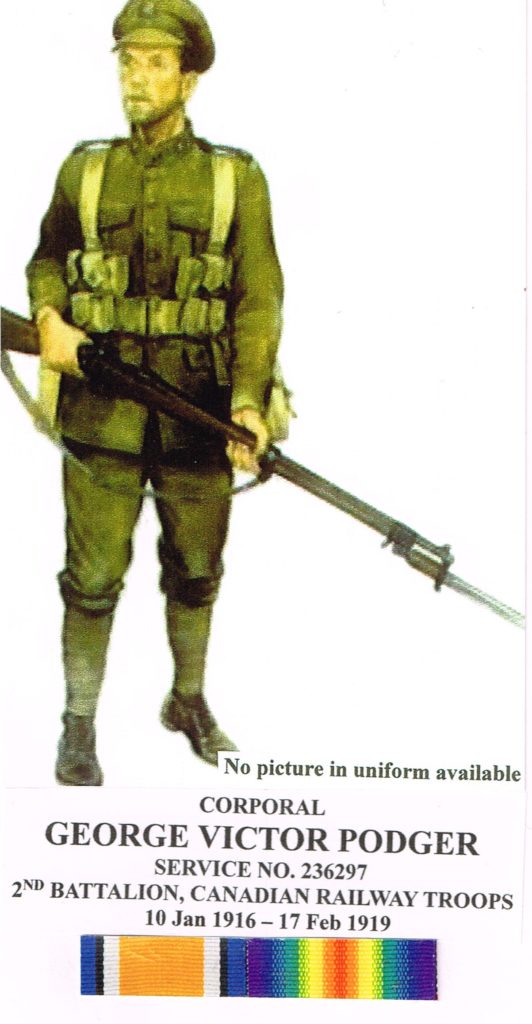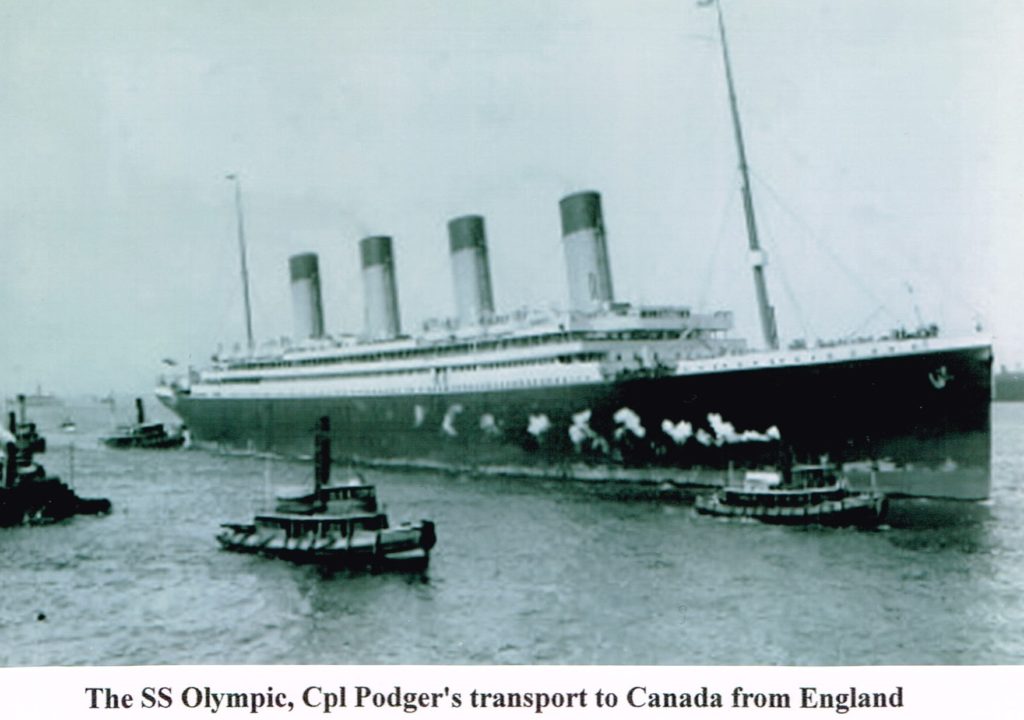MILITARY HISTORY
Corporal George Victor Podger – 736297 — ACTIVE SERVICE (World War I)
On January 10, 1916 George Victor Podger completed the Attestation Paper for the Canadian Army, Canadian Expeditionary Force (CEF) in Lethbridge, Alberta. He was 21 years, 23 days old when, as a single man, he enlisted for the duration of the War. George Victor was born in Bridgenorth, Ontario and gave his birth-date as December 18, 1894. He gave his current address as 625 -14th St., South, Lethbridge Alberta. He indicated that he did not presently belong to a Militia Force and had no previous Military experience. There is nothing on George Victor’s File to indicate where he was educated or to what level (it is expected that he was educated in Bridgenorth). As far as his Trade or Calling is concerned, he lists Office Worker. George Victor was 5′ 5” tall, with a 30” chest (expanded) and he weighed 125 pounds; he had a ruddy complexion with blue eyes and dark brown hair. George Victor’s Medical Examination was completed January 10, 1916 in Lethbridge, Alberta. He had no significant medical issues or physical limitations; he was deemed fit for Overseas duty with the CEF. His next-of-kin was listed as his mother, Mrs. Elizabeth Podger of Okotoks, Alberta. George Victor Podger signed the Oath and Certificate of Attestation on January 10, 1916 in Lethbridge. He was taken-on-strength with the 113th Overseas Battalion (O/S Bn) as a Private (Pte) and was assigned Service Number 736297.
Pte Podger’s File doesn’t have any record of the 8 months between January and September 1916. Following normal Military procedures he would have undergone Basic and Advanced Military Training with the 113th O/S Bn. This training would have covered Military Law, discipline, marching, saluting, cleaning kit, rifle, etc. Advanced Training would have included mortars, grenades, machine guns, map reading and so on.
September 18, 1916 Pte Podger indicated that he was insured with the Great West Life Insurance Company but maintenance of the premium was not being paid. On September 25, 1916 Pte Podger embarked from Halifax, Nova Scotia aboard the SS Tuscania bound for England; October 6, 1916 he disembarked Liverpool, England. October 8, 1916 Pte Podger is struck-off-strength from the 113th O/S Bn to the 17th Reserve (Res) Bn at East Sandling, England and was taken-on-strength to the 17th Res Bn.
Pte Podger’s records don’t cover the 2 months from October 8 to December 8, 1916; he would have been training and doing assigned duties with the 17th Res Bn. On December 8, 1916 Pte Podger was struck-off-strength from the 17th Res Bn to the 32nd Bn and taken-on-strength to the 32nd Bn at East Sandling. December 13, 1916 he was struck-off-strength from the 32nd Bn and taken-on-strength back to the 17th Bn at East Sandling and then was immediately struck-off-strength from the 17th Res Bn and taken-on-strength to the 127th Bn at Bordon, England. January 12, 1917 Pte Podger proceeded for Service Overseas with the 127th Bn from the 17th Res Bn and embarked England (no ship mentioned) for France. He disembarked at Le Havre, France on January 13, 1917.
February 10, 1917 the designation of the 127th Bn was changed to the 2nd Bn, *Canadian Railway Troops (CRT). *Canadian Railway Troops were men recruited and organized to operate railways in rear areas. February 24, 1917 Pte Podger was appointed as an Acting Corporal (A/Cpl) in the Field. On February 25, 1917 A/Cpl Podger was confirmed in the Rank of Corporal (Cpl). Another 4 months of activity, between February 25 and July 1, 1917 has no records, but Cpl Podger would have been training with the 2nd Bn, CRT for the Railway tasking and performing other assigned duties. On July 1, 1917 Pte Podger made a Pay Assignment of $20.00 monthly to his mother, Mrs. Elizabeth Podger. The following 6 months probably would have been spent employed with the 2nd Bn, CRT.
January 6, 1918 Cpl Podger was granted 24 days Leave in the United Kingdom (UK) and returned to the 2nd Bn, CRT on January 23, 1918. March 26, 1918 Cpl Podger received a bomb-wound (shrapnel) to his head. After being hit with the shrapnel on the left side of his skull he was unconscious for 24 hours. Cpl Podger was removed to a hospital and the area of the skull was trephined (a small circular saw is used to remove small circular discs of bone from the skull); all wounds healed. April 5, 1918 Cpl Podger was admitted to No 10 General Hospital at Rouen, France with a shrapnel head wound. April 11, 1918 he is transported to England due to the head wound by HMHS Essequibo (hospital ship). Cpl Podger would have embarked France on the hospital ship and disembarked at England
 April 14, 1918 Cpl Podger was struck-off-strength from the 2nd Bn, CRT and taken-on-strength to the Depot of the CRT. April 15, 1918 he was classed an “invalided wounded” and admitted to the hospital; on this day his mother, Elizabeth Podger was living at 103 Maitland St., Toronto Ontario. April 16, 1918 Cpl Podger was posted to the CRT Depot at Purfleet, England. April 17, 1918 he was at No 4 Canadian General Hospital at Basingstoke, England. On May 14, 1918 Cpl Podger was at the Military Convalescent Hospital at Woodcote, Epsom, England.
April 14, 1918 Cpl Podger was struck-off-strength from the 2nd Bn, CRT and taken-on-strength to the Depot of the CRT. April 15, 1918 he was classed an “invalided wounded” and admitted to the hospital; on this day his mother, Elizabeth Podger was living at 103 Maitland St., Toronto Ontario. April 16, 1918 Cpl Podger was posted to the CRT Depot at Purfleet, England. April 17, 1918 he was at No 4 Canadian General Hospital at Basingstoke, England. On May 14, 1918 Cpl Podger was at the Military Convalescent Hospital at Woodcote, Epsom, England.
July 5, 1918 Cpl Podger was discharged from the Military Convalescent Hospital and was placed On-Command to No 3 Canadian Convalescent Depot (CCD) at Seaford, England. September 5, 1918 he ceased to be On-Command to No 3 CCD. November 27, 1918 Cpl Podger had a Medical Examination at Purfleet, Essex, England. He complained of some headaches on exertion. Cpl Podger has a crescentic scar over the left ear as a result of the shrapnel wound he suffered, he was deemed “fit A”.
December 3, 1918 Cpl Podger was struck-off-strength from the CRT Depot on embarkation England to Canada and was taken-on-strength of No 13 District Depot (DD). December 7, 1918 was struck-off-strength on transfer to the Overseas Military Forces of Canada (OMF of C) to CEF, Canada and embarked at England bound for Canada. December 14, 1918 he arrived in Halifax, Nova Scotia aboard the SS Olympic. On this day Cpl Podger’s mother Elizabeth was living at 626 – 14th St., South, Lethbridge, Alberta. December 20, 1918 Cpl Podger was posted to the Casualty Company at Calgary.
January 4, 1919 Cpl Podger was granted Leave with Subsistence Allowance. January 22, 1919 Cpl Podger was hospitalized with Tonsillitis which cleared-up without surgery. January 28, 1919 he was transferred to the Casualty Company at Calgary. January 30, 1919 Cpl Podger had a Medical Examination at Calgary, Alberta, a statement was made: “that there is present no disability except for these dizzy spells and headaches”.
On February 17, 1919 Corporal George Victor Podger was discharged from the Service by No 13 DD at Calgary. On February 14, 1919 Cpl Podger received a Last Pay of $75.41; he also received his War Service Gratuity of $420.00.
There is no mention in Corporal George Victor Podger’s File with regards to what Military Medals he was eligible to receive or was awarded. Based on his Military Service, he was awarded the:
British War Medal; and
Victory Medal.
He would have also received the CEF Class “A” War service Badge.
Based on his Military File, Corporal George Victor Podger served a total of 2 years, 12 days with the Canadian Expeditionary Force: 4 months, 5 days in Canada, 1 months, 25 days in England, 1 year, 5 months, 27 days in France plus 15 days of travel time.
An excerpt from an article in Maclean’s Magazine by Barbara Ameil, September 1996:
The Military is the single calling in the world with job specifications that include a commitment to die for your country. What could be more honourable?
PERSONAL HISTORY
GEORGE VICTOR PODGER
George Victor Podger was born in Bridgenorth, Ontario on December 18, 1894. He was the oldest son of George Sidney Podger and Elizabeth “Lizzie” Swan Ridpath. He received his education in Bridgenorth, Ontario.
By 1901 the family was living in Toronto and by 1911 the family had settled in Okotoks, Alberta. George was working as an office clerk when he decided to enlist in World War I and on January 10, 1916, he went to Lethbridge, Alberta and signed up to serve his country.
Upon his return from the war, George married Clara Violet Grainger and they settled in British Columbia. Clara Violet Podger died in Burnaby, BC on September 10, 1942 and George Victor Podger passed away in Shaughnessy Hospital, Vancouver, BC on September 30, 1951 in his 59th year; both are buried in the Forest Lawn Memorial Park Cemetery in Burnaby, B.C.
George Victor Podger was a member of Knox Presbyterian Church and is included on a Memorial Plaque that hung in Knox Presbyterian Church which remembers with honour their members who served in the Armed Forces during World War I. This plaque was later moved to the Sanctuary of Lakefield United Church on Regent Street in 1932 after the two churches merged to form Lakefield United Church.
THE GEORGE VICTOR PODGER FAMILY OF LAKEFIELD
The paternal grandparents of George Victor Podger were William Podger born in 1836 in England and Mary Jane Morley born in 1836. They lived in the Lakefield area and had a family of six children. Mary Jane died in December 1890 and William died on November 16, 1896; both are buried in the Lakefield Cemetery.
His maternal grandparents were Samuel Ridpath born in 1840 in England and Jane Isbister born in 1849. Samuel and Jane lived in Lakefield and Samuel was a tailor. They had a family of nine children. Samuel passed away on January 7, 1895 and Jane died on March 25, 1927; both are buried in the Lakefield Cemetery.
George’s parents were George Sidney Podger born in Ontario in 1865 and Elizabeth “Lizzie” Swan Ridpath born in 1870. They were married in Lakefield, Ontario on August 7, 1889 and made their home in Lakefield while George worked as a miller. By 1894 the family was living in the Bridgenorth area and the 1901 Ontario Census has the family living in Toronto working as a miller. In 1911 the family was living in Lethbridge, Alberta and remained there until 1920. They had a family of six children: Rietta Jane; George “Victor”; Lillian Grace; Lloyd Kingsley; Muriel Ida and Dorothy Wilhelmina Podger.
In 1920, George and Elizabeth moved to British Columbia and remained there until their death. Elizabeth died in Vancouver on April 22, 1950 and George Sidney died in Surrey on April 26, 1955; both are buried in the Forest Lawn Memorial Park Cemetery in Burnaby, B.C.


